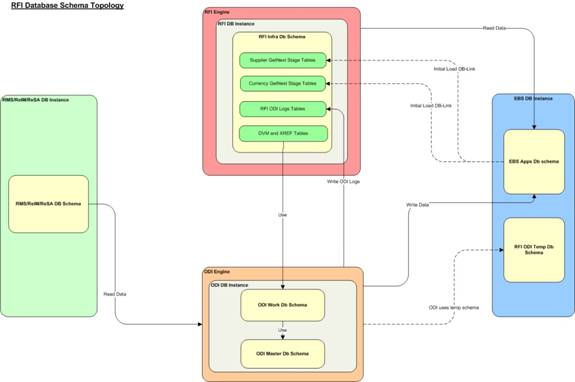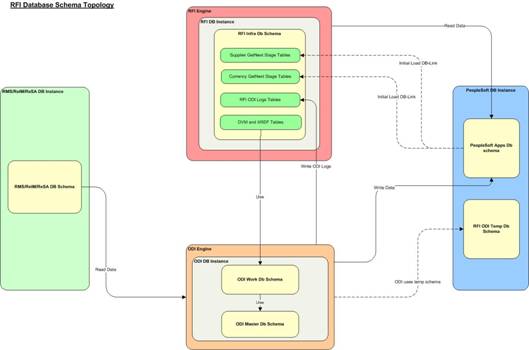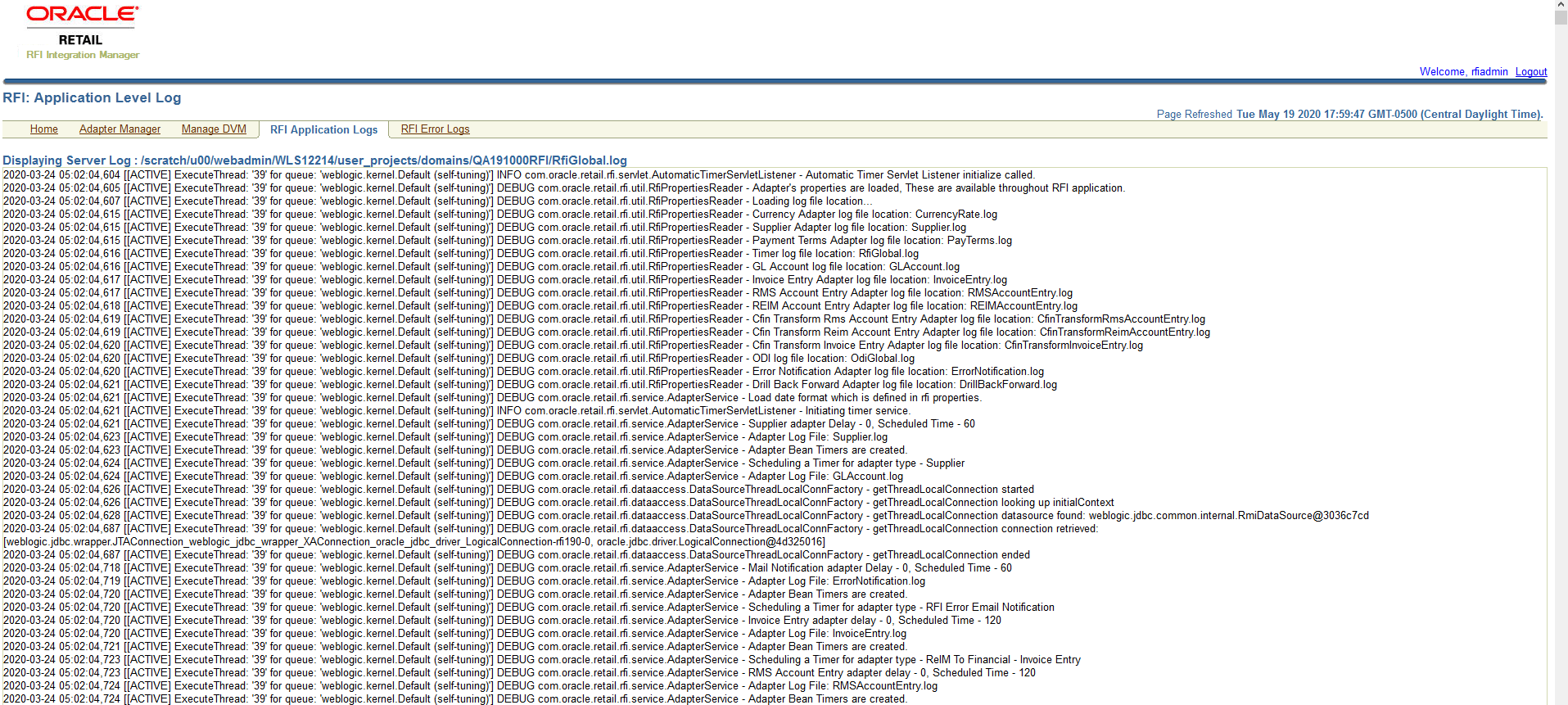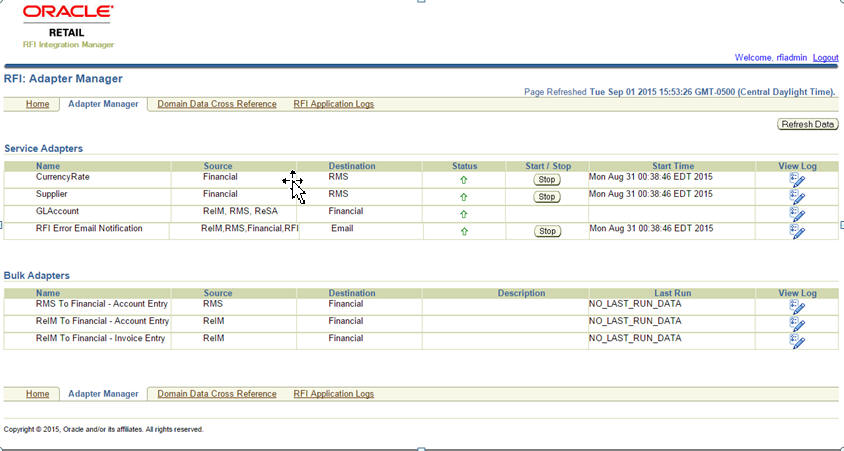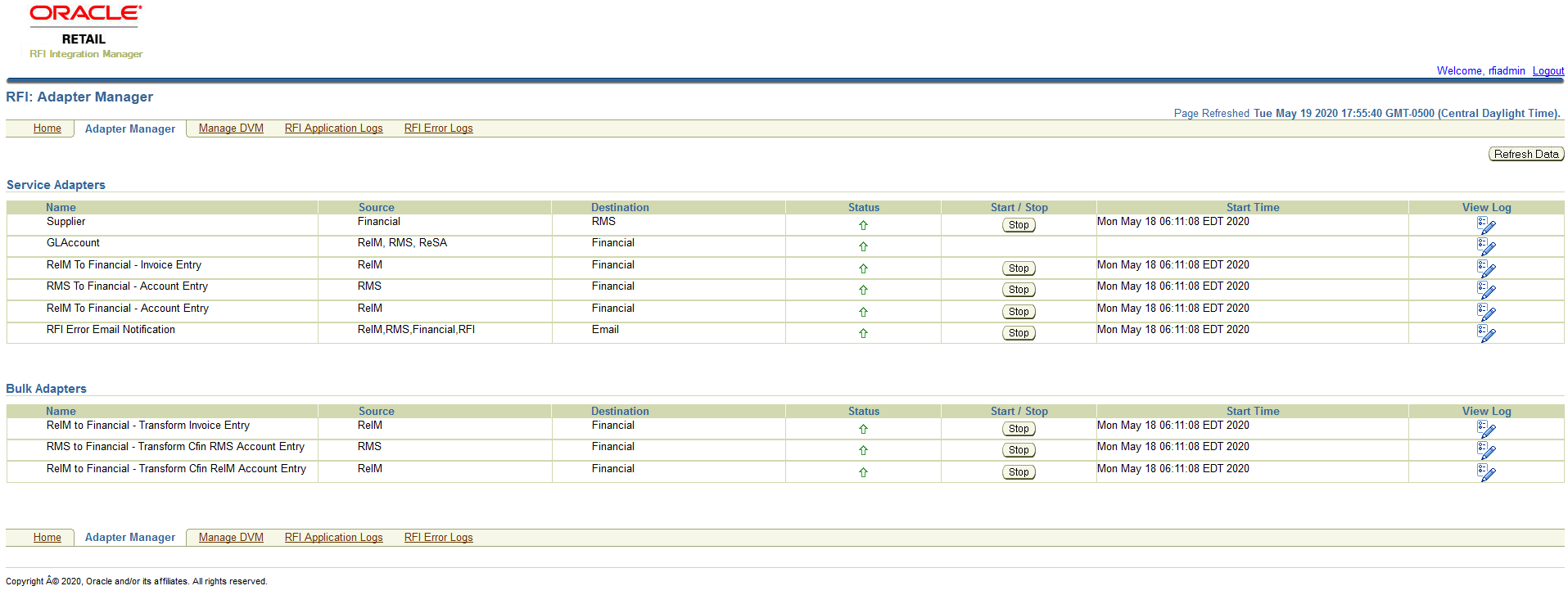|
BUSINESS_UNIT_DVM
|
RETL_ID, EXT_SYSTEM_ID
|
This maps Oracle Retail's Set Of Books ID to Oracle GL business unit (Ledger Id).
EBS and CFIN Table: GL_LEDGERS
Retail Table: FIF_GL_SETUP
|
111
|
abc
|
Applicable for all systems (EBS/PSFT/CFIN)
|
|
COA_STATUS_DVM
|
RETL_ID, EXT_SYSTEM_ID
|
This is a hard coded DVM and should not be changed. This maps the EBS value of "TRUE" or "FALSE" to Oracle Retail's value of "valid" or "invalid".
|
True,
False,
|
TRUE/FALSE for EBS or PSFT,
Valid/Invalid for CFIN
|
Applicable for all systems (EBS/PSFT/CFIN)
|
|
ADDRESS_COUNTRY_DVM
|
RETL_ID, EXT_SYSTEM_ID
|
Holds the supplier address country code value mapping between RMS and financial system.
|
US
|
US
|
Applicable for all systems (EBS/PSFT/CFIN)
|
|
CURR_CONV_TYPE_CODE_DVM
|
RETL_ID, EXT_SYSTEM_ID
|
RMS has some set exchange rate type values (Operational, Consolidated, etc.) and CFIN and other financials systems also have exchange rate types (and these may be configurable). A Common exchange rate type that would be used in Financials would be "Spot" and this would correspond to Operational in RMS. So, a DVM between these two values should exist. For ReIM, when we send documents to AP we send an exchange rate when needed, but the rate type we send is always "USER" to ensure that CFIN doesn't try to validate that it is the correct rate for a given date. So we also need to have DVM for "User" rate types.
|
A,User
|
CRRNT,
User
|
Applicable for all systems (EBS/PSFT/CFIN)
|
|
CURR_CODE_DVM
|
RETL_ID, EXT_SYSTEM_ID
|
Holds the currency code value mapping between RMS and financial system.
|
USD
|
USD
|
Applicable for all systems (EBS/PSFT/CFIN)
|
|
LANGUAGE_CODE_DVM
|
RETL_ID, EXT_SYSTEM_ID
|
Holds the supplier language code value mapping between RMS and financial system.
|
EN
|
EN
|
Applicable for all systems (EBS/PSFT/CFIN)
|
|
COA_GLELEMENT_REIM_DVM
|
RETL_ID, EXT_SYSTEM_ID
|
Segment name mappings between REIM and EBS or CFIN. The value lookup has the entry like < Set of Books ID >-SEGMENT1 for Retail value and < Ledger id>-SEGMENT1 for the E-business suite or CFIN value.
|
111-SEGMENT1,
111-SEGMENT2,
…111-SEGMENTN.
|
123-SEGMENT1,
123-SEGMENT2,
…123-SEGMENTN.
|
Applicable for all systems (EBS/PSFT/CFIN)
|
|
COA_GLELEMENT_RESA_DVM
|
Segment name mappings between RESA and EBS or CFIN. The value lookup has the entry like < Set of Books ID >-SEGMENT1 for Retail value and < Ledger id>-SEGMENT1 for the E-business suite or CFIN value.
|
111-SEGMENT1,
111-SEGMENT2,
…111-SEGMENTN.
|
123-SEGMENT1,
123-SEGMENT2,
…123-SEGMENTN.
|
Applicable for all systems (EBS/PSFT/CFIN)
|
|
COA_GLELEMENT_RMS_DVM
|
Segment name mappings between RMS and EBS or CFIN. The value lookup has the entry like < Set of Books ID >-SEGMENT1 for Retail value and < Ledger id>-SEGMENT1 for the E-business suite or CFIN value.
|
111-SEGMENT1,
111-SEGMENT2,
…111-SEGMENTN.
|
123-SEGMENT1,
123-SEGMENT2,
…123-SEGMENTN.
|
Applicable for all systems (EBS/PSFT/CFIN)
|
|
STATE_DVM
|
RETL_ID, EXT_SYSTEM_ID
|
Holds the supplier address State code value mapping between RMS and financial system.
|
MN
|
MN
|
Applicable for all systems (EBS/PSFT/CFIN)
|
|
SUPPLIER_ADDRESS_TYPE_DVM
|
RETL_ID, EXT_SYSTEM_ID
|
Holds the supplier Site type value (Pay/Purchase) mapping between RMS and financial system. RFI sends only two types of address to RMS(Pay/Purchase). RMS adds 01 type of supplier address in each site by default. Primary supplier in RMS takes the types from first site it processes.
|
04,06
|
PURCHASING_SITE_FLAG.
PAY_SITE_FLAG
|
Applicable for all systems (EBS/PSFT/CFIN)
|
|
SUPPLIER_STATUS_CODE_DVM
|
RETL_ID, EXT_SYSTEM_ID
|
This maps the supplier's status between Oracle Retail and Oracle Payables."I" for Inactive and "A" for Active status in both Retail and EBS or CFIN.
|
I,A
|
I,A
|
Applicable for all systems (EBS/PSFT/CFIN)
|
|
TAX_DVM
|
RETL_ID, EXT_SYSTEM_ID
|
This maps the Tax code (VAT) between Oracle Retail and EBS or CFIN
|
S
|
S
|
Applicable for all systems (EBS/PSFT/CFIN)
|
|
SUPPLIER_PRIMARY_SITE_FLAG_DVM
|
RETL_ID, EXT_SYSTEM_ID
|
Holds the Primary site flag value mapping, If site coming from finacial system is primary then same information is passed to RMS wuith this flag value.
|
Y
|
Y
|
Applicable for all systems (EBS/PSFT/CFIN)
|
|
FREIGHT_TERMS_XREF
|
RETL_ID, EXT_SYSTEM_ID
|
Holds Freight terms mapping.
|
1
|
ORIGIN
|
Applicable for all systems (EBS/PSFT/CFIN)
|
|
PAYMENT_TERMS_XREF
|
RETL_ID, EXT_SYSTEM_ID
|
Manual Sync for EBS and Inserted by Pay terms integration adapter for PeopleSoft.
|
111
|
xyz corporation
|
Applicable for all systems (EBS/PSFT/CFIN)
|
|
ORG_ID_XREF
|
|
|
111
|
123
|
Applicable for all systems (EBS/PSFT/CFIN)
|
|
SUPPLIER_XREF
|
|
|
400
|
445566
|
Applicable for all systems (EBS/PSFT/CFIN)
|
|
SUPPLIER_SITE_NAME_XREF
|
|
|
401
|
401 suppliner site name
|
Applicable for all systems (EBS/PSFT/CFIN)
|
|
VENDOR_FILTER_XREF
|
|
Supplier Filter Criteria
|
'VENDOR_TYPE_LOOKUP_CODE,
Any column from rfi_Supp_stage like attributes column
|
TAX AUTHORITY,
Any other value under selected colun length limit
|
Applicable for all systems (EBS/PSFT/CFIN)
|
|
COA_GLELEMENT_LEDGER_GROUP_DVM
|
|
|
11111
|
US001-RECORDING
|
Applicable for all systems (PSFT)
|
|
TSF_ENTITY_XREF
|
|
|
111
|
abc
|
Applicable for all systems (EBS/PSFT/CFIN)
|
|
PROC_ORG_UNIT_TO_FIN_ORG_UNIT_DVM
|
|
|
111
|
abc
|
Applicable for all systems (EBS/PSFT/CFIN)
|
|
SOB_ID_TO_LEDGER_ID_DVM
|
|
|
111
|
1
|
Applicable for all systems (EBS/PSFT/CFIN)
|
|
BUSINESS_UNIT_DVM
|
RETL_ID, EXT_SYSTEM_ID
|
This maps Oracle Retail's Set Of Books ID to Oracle GL business unit (Ledger Id).
EBS and CFIN Table: GL_LEDGERS
Retail Table: FIF_GL_SETUP
|
111
|
abc
|
Applicable for all systems (EBS/PSFT/CFIN)
|
|
COA_STATUS_DVM
|
RETL_ID, EXT_SYSTEM_ID
|
This is a hard coded DVM and should not be changed. This maps the EBS value of "TRUE" or "FALSE" to Oracle Retail's value of "valid" or "invalid".
|
True,
False,
|
TRUE/FALSE for EBS or PSFT,
Valid/Invalid for CFIN
|
Applicable for all systems (EBS/PSFT/CFIN)
|
|
ADDRESS_COUNTRY_DVM
|
RETL_ID, EXT_SYSTEM_ID
|
Holds the supplier address country code value mapping between RMS and financial system.
|
US
|
US
|
Applicable for all systems (EBS/PSFT/CFIN)
|
|
CURR_CONV_TYPE_CODE_DVM
|
RETL_ID, EXT_SYSTEM_ID
|
RMS has some set exchange rate type values (Operational, Consolidated, etc.) and CFIN and other financials systems also have exchange rate types (and these may be configurable). A Common exchange rate type that would be used in Financials would be "Spot" and this would correspond to Operational in RMS. So, a DVM between these two values should exist. For ReIM, when we send documents to AP we send an exchange rate when needed, but the rate type we send is always "USER" to ensure that CFIN doesn't try to validate that it is the correct rate for a given date. So we also need to have DVM for "User" rate types.
|
A,User
|
CRRNT,
User
|
Applicable for all systems (EBS/PSFT/CFIN)
|
|
CURR_CODE_DVM
|
RETL_ID, EXT_SYSTEM_ID
|
Holds the currency code value mapping between RMS and financial system.
|
USD
|
USD
|
Applicable for all systems (EBS/PSFT/CFIN)
|
|
LANGUAGE_CODE_DVM
|
RETL_ID, EXT_SYSTEM_ID
|
Holds the supplier language code value mapping between RMS and financial system.
|
EN
|
EN
|
Applicable for all systems (EBS/PSFT/CFIN)
|
|
COA_GLELEMENT_REIM_DVM
|
RETL_ID, EXT_SYSTEM_ID
|
Segment name mappings between REIM and EBS or CFIN. The value lookup has the entry like < Set of Books ID >-SEGMENT1 for Retail value and < Ledger id>-SEGMENT1 for the E-business suite or CFIN value.
|
111-SEGMENT1,
111-SEGMENT2,
…111-SEGMENTN.
|
123-SEGMENT1,
123-SEGMENT2,
…123-SEGMENTN.
|
Applicable for all systems (EBS/PSFT/CFIN)
|
|
COA_GLELEMENT_RESA_DVM
|
Segment name mappings between RESA and EBS or CFIN. The value lookup has the entry like < Set of Books ID >-SEGMENT1 for Retail value and < Ledger id>-SEGMENT1 for the E-business suite or CFIN value.
|
111-SEGMENT1,
111-SEGMENT2,
…111-SEGMENTN.
|
123-SEGMENT1,
123-SEGMENT2,
…123-SEGMENTN.
|
Applicable for all systems (EBS/PSFT/CFIN)
|
|
COA_GLELEMENT_RMS_DVM
|
Segment name mappings between RMS and EBS or CFIN. The value lookup has the entry like < Set of Books ID >-SEGMENT1 for Retail value and < Ledger id>-SEGMENT1 for the E-business suite or CFIN value.
|
111-SEGMENT1,
111-SEGMENT2,
…111-SEGMENTN.
|
123-SEGMENT1,
123-SEGMENT2,
…123-SEGMENTN.
|
Applicable for all systems (EBS/PSFT/CFIN)
|
|
STATE_DVM
|
RETL_ID, EXT_SYSTEM_ID
|
Holds the supplier address State code value mapping between RMS and financial system.
|
MN
|
MN
|
Applicable for all systems (EBS/PSFT/CFIN)
|
|
SUPPLIER_ADDRESS_TYPE_DVM
|
RETL_ID, EXT_SYSTEM_ID
|
Holds the supplier Site type value (Pay/Purchase) mapping between RMS and financial system. RFI sends only two types of address to RMS(Pay/Purchase). RMS adds 01 type of supplier address in each site by default. Primary supplier in RMS takes the types from first site it processes.
|
04,
06
|
PURCHASING_SITE_FLAG.
PAY_SITE_FLAG
|
Applicable for all systems (EBS/PSFT/CFIN)
|
|
SUPPLIER_STATUS_CODE_DVM
|
RETL_ID, EXT_SYSTEM_ID
|
This maps the supplier's status between Oracle Retail and Oracle Payables."I" for Inactive and "A" for Active status in both Retail and EBS or CFIN.
|
I,
A
|
I,
A
|
Applicable for all systems (EBS/PSFT/CFIN)
|
|
TAX_DVM
|
RETL_ID, EXT_SYSTEM_ID
|
This maps the Tax code (VAT) between Oracle Retail and EBS or CFIN
|
S
|
S
|
Applicable for all systems (EBS/PSFT/CFIN)
|
|
SUPPLIER_PRIMARY_SITE_FLAG_DVM
|
RETL_ID, EXT_SYSTEM_ID
|
Holds the Primary site flag value mapping, If site coming from finacial system is primary then same information is passed to RMS wuith this flag value.
|
Y
|
Y
|
Applicable for all systems (EBS/PSFT/CFIN)
|
|
FREIGHT_TERMS_XREF
|
RETL_ID, EXT_SYSTEM_ID
|
Holds Freight terms mapping.
|
1
|
ORIGIN
|
Applicable for all systems (EBS/PSFT/CFIN)
|
|
PAYMENT_TERMS_XREF
|
RETL_ID, EXT_SYSTEM_ID
|
Manual Sync for EBS and Inserted by Pay terms integration adapter for PeopleSoft.
|
111
|
xyz corporation
|
Applicable for all systems (EBS/PSFT/CFIN)
|
|
ORG_ID_XREF
|
RETL_ID, EXT_SYSTEM_ID
|
Holds Org Unit mapping between retail and financial system
|
111
|
123
|
Applicable for all systems (EBS/PSFT/CFIN)
|
|
SUPPLIER_XREF
|
RETL_ID, EXT_SYSTEM_ID
|
Holds supplier id mapping between retail and financial system, This xref gets automatically created when new supplier is passed from financial system. If this xref is already present then supplier will be considered for update else it will be considered as new.
|
400
|
445566
|
Applicable for all systems (EBS/PSFT/CFIN)
|
|
SUPPLIER_SITE_XREF
|
RETL_ID, EXT_SYSTEM_ID
|
Holds supplier site id mapping between retail and financial system, This xref gets automatically created when new supplier site is passed along with supplier info from financial system. If this xref is already present then supplier site will be considered for update else it will be considered as new.
|
401
|
445577
|
Applicable for all systems (EBS/PSFT/CFIN)
|
|
SUPPLIER_SITE_NAME_XREF
|
RETL_ID, EXT_SYSTEM_ID
|
Holds supplier site id with supplier site name mapping between retail and financial system, This xref gets automatically created when new supplier site is passed along with supplier info from financial system. If this xref is already present then supplier site will be considered for update else it will be considered as new. This Xref is used in CFIN Invoice interface to pass the site code in outgoing file.
|
401
|
401 suppliner site name
|
Applicable for all systems (EBS/PSFT/CFIN)
|
|
VENDOR_FILTER_XREF
|
RETL_ID, EXT_SYSTEM_ID
|
Supplier Filter Criteria
|
'VENDOR_TYPE_LOOKUP_CODE,
Any column from rfi_Supp_stage like attributes column
|
TAX AUTHORITY,
Any other value under selected colun length limit
|
Applicable for all systems (EBS/PSFT/CFIN)
|
|
COA_GLELEMENT_LEDGER_GROUP_DVM
|
RETL_ID, EXT_SYSTEM_ID
|
Ledger Group mapping with Business Unit. Used only when PeopleSoft is the Oracle Financials application
|
11111
|
US001-RECORDING
|
Applicable for all systems (PSFT)
|
|
TSF_ENTITY_XREF
|
RETL_ID, EXT_SYSTEM_ID
|
Transfer entity to legal entity. Maps RMS TSF_ENTITY_ID value from TSF_ENTITY table.
|
111
|
abc
|
Applicable for all systems (EBS/PSFT/CFIN)
|
|
PROC_ORG_UNIT_TO_FIN_ORG_UNIT_DVM
|
RETL_ID, EXT_SYSTEM_ID
|
Proc org unit to financial org unit. Maps RMS ORG_UNIT_ID value from ORG_UNIT table.
|
111
|
abc
|
Applicable for all systems (EBS/PSFT/CFIN)
|
|
SOB_ID_TO_LEDGER_ID_DVM
|
RETL_ID, EXT_SYSTEM_ID
|
Maps the set of books id to ledger id
|
111
|
1
|
Applicable for all systems (EBS/PSFT/CFIN)
|



